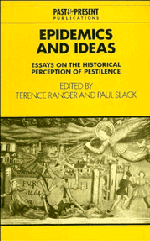Book contents
- Frontmatter
- Contents
- Contributors
- Preface
- 1 Introduction
- 2 Epidemic, ideas and classical Athenian society
- 3 Disease, dragons and saints: the management of epidemics in the Dark Ages
- 4 Epidemic disease in formal and popular thought in early Islamic Society
- 5 Plague and perceptions of the poor in early modern Italy
- 6 Dearth, dirt and fever epidemics: rewriting the history of British ‘public health’, 1780–1850
- 7 Epidemics and revolutions: cholera in nineteenth-century Europe
- 8 Hawaiian depopulation as a model for the Amerindian experience
- 9 Plague panic and epidemic politics in India, 1896–1914
- 10 Plagues of beasts and men; prophetic responses to epidemic in eastern and southern Africa
- 11 Syphilis in colonial East and Central Africa: the social construction of an epidemic
- 12 The early years of AIDS in the United Kingdom 1981–6: historical perspectives
- Index
- Past and Present Publications
4 - Epidemic disease in formal and popular thought in early Islamic Society
Published online by Cambridge University Press: 05 August 2011
- Frontmatter
- Contents
- Contributors
- Preface
- 1 Introduction
- 2 Epidemic, ideas and classical Athenian society
- 3 Disease, dragons and saints: the management of epidemics in the Dark Ages
- 4 Epidemic disease in formal and popular thought in early Islamic Society
- 5 Plague and perceptions of the poor in early modern Italy
- 6 Dearth, dirt and fever epidemics: rewriting the history of British ‘public health’, 1780–1850
- 7 Epidemics and revolutions: cholera in nineteenth-century Europe
- 8 Hawaiian depopulation as a model for the Amerindian experience
- 9 Plague panic and epidemic politics in India, 1896–1914
- 10 Plagues of beasts and men; prophetic responses to epidemic in eastern and southern Africa
- 11 Syphilis in colonial East and Central Africa: the social construction of an epidemic
- 12 The early years of AIDS in the United Kingdom 1981–6: historical perspectives
- Index
- Past and Present Publications
Summary
In considering the impact of epidemic disease on a society, historians usually conceive of their task in terms of problems of mortality and such associated discontinuities as the collapse of orderly government, the flight of threatened populations and the disruption of agriculture and trade. Important as these factors are, however, they tend to obscure the fact that, in terms of the perceptions of the peoples at risk, of no less significance is the fact that epidemic disease in the past has held, and today continues to hold, some of its worst terrors in the way it challenges the ideological structures that sustain all societies.
This is not simply a matter of explaining away incomprehensible horrors. The ideological underpinnings of a social system – whether in the form of political ideology, myth or religion – serve to rationalise the physical world in terms of the priorities, agenda and claims of the society generating these structures, and they comprise an ongoing discourse of self-definition that both responds to changes in social perceptions and historical circumstances and figures in the determination of how that society will react to any further changes or new developments. As these structures encompass the very essence and cohesive elements of a society – its sense of origins, identity, purpose and future – threats of the gravest and most disruptive kind are posed by challenges that falsify the assumptions and claims made in these structures.
- Type
- Chapter
- Information
- Epidemics and IdeasEssays on the Historical Perception of Pestilence, pp. 77 - 100Publisher: Cambridge University PressPrint publication year: 1992
- 4
- Cited by



